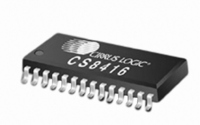CS8416-CNZ Cirrus Logic Inc, CS8416-CNZ Datasheet - Page 22

CS8416-CNZ
Manufacturer Part Number
CS8416-CNZ
Description
IC RCVR DGTL 192KHZ 28QFN COMM
Manufacturer
Cirrus Logic Inc
Type
Digital Audio Interface Receiverr
Datasheet
1.CS8416-CZZ.pdf
(60 pages)
Specifications of CS8416-CNZ
Applications
Digital Audio
Mounting Type
Surface Mount
Package / Case
28-QFN
Audio Control Type
Digital
Control Interface
I2C, SPI
Control / Process Application
AV & DVD Receivers, CD-R, Digital Mixing Consoles
Supply Voltage Range
3.13V To 5.25V, 3.13V To 3.46V
Lead Free Status / RoHS Status
Lead free / RoHS Compliant
For Use With
598-1017 - BOARD EVAL FOR CS8416 RCVR
Lead Free Status / RoHS Status
Lead free / RoHS Compliant, Lead free / RoHS Compliant
Other names
598-1723
22
5. APPLICATIONS
5.1
5.2
5.3
Reset, Power-Down and Start-Up
When RST is low, the CS8416 enters a low power mode and all internal states are reset, including the con-
trol port and registers, and the outputs are muted. In Software Mode, when RST is high, the control port
becomes operational, and the desired settings should be loaded into the control registers. Writing a 1 to the
RUN bit will then cause the part to leave the low power state and begin operation. After the PLL has settled,
the serial audio outputs will be enabled.
Some options within the CS8416 are controlled by a start-up mechanism. During the reset state, some of
the pins are reconfigured internally to be inputs. Immediately upon exiting the reset state, the level of these
pins is sensed. The pins are then switched to be outputs. This mechanism allows output pins to be used to
set alternative modes in the CS8416 by connecting a 47 k Ω resistor to between the pin and either VL (HI)
or DGND (LO). For each mode, every start-up option select pin MUST have an external pull-up or pull-down
resistor as there are no internal pull-up or pull-down resistors for these startup conditions (except for TX,
which has an internal pull-down). In Software Mode, the only start-up option pins are GPO2, which are used
to set a chip address bit for the control port in I²C Mode, and SDOUT, which selects between Hardware and
Software Modes. The Hardware Mode uses many start-up options, which are detailed in
ware Mode Function Selection” on page
ID Code and Revision Code
The CS8416 has a register that contains a 4-bit code to indicate that the addressed device is a CS8416.
This is useful when other CS84XX family members are resident in the same system, allowing common soft-
ware modules.
The CS8416 4-bit revision code is also available. This allows the software driver for the CS8416 to identify
which revision of the device is in a particular system, and modify its behavior accordingly. To allow for future
revisions, it is strongly recommend that the revision code is read into a variable area within the microcon-
troller, and used wherever appropriate as revision details become known.
Power Supply, Grounding, and PCB Layout
For most applications, the CS8416 can be operated from a single +3.3 V supply, following normal supply
decoupling practices (See
RMCK pin, is required to be low jitter, then use a separate, quiet, analog +3.3 V supply for VA, decoupled
to AGND. Make certain that no digital traces are routed near VA, AGND, or FILT as noise may couple and
degrade performance. These pins should be well isolated from switching signals and other noise sources.
VL sets the level for the digital inputs and outputs, as well as the AES/SPDIF receiver inputs.
Extensive use of power and ground planes, ground plane fill in unused areas and surface mount decoupling
capacitors are recommended. Decoupling capacitors should be mounted on the same side of the board as
the CS8416 to minimize inductance effects, and all decoupling capacitors should be as close to the CS8416
as possible. See
“PLL Filter” on page 53
Figures 5
and 6). For applications where the recovered input clock, output on the
46.
for layout recommendations for the PLL.
Section 15.2 “Hard-
CS8416
DS578F3
















